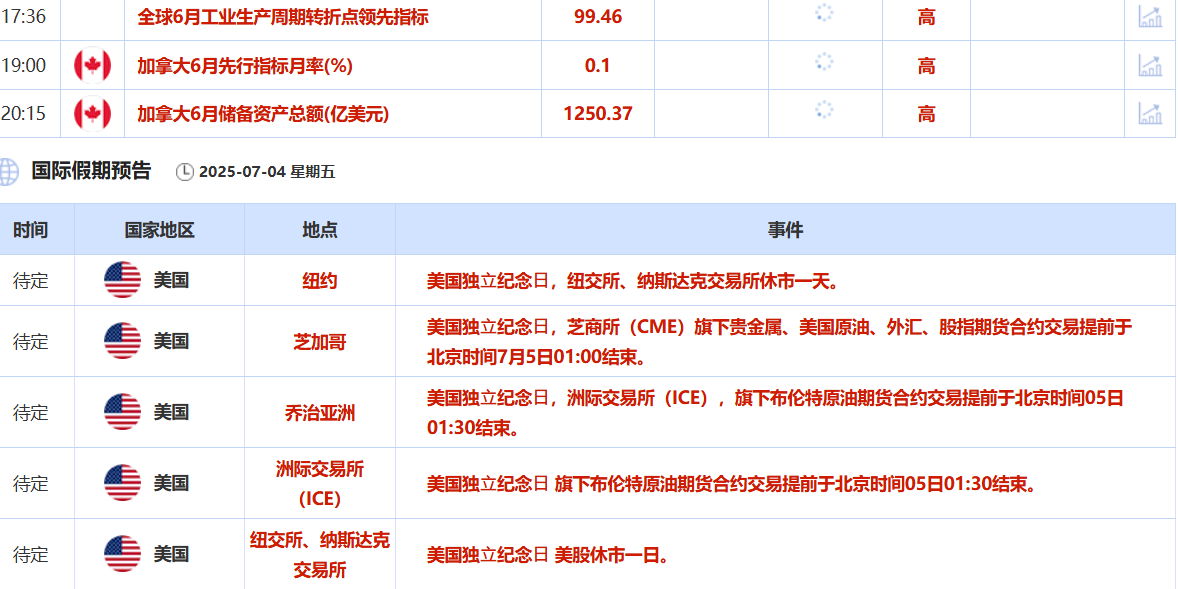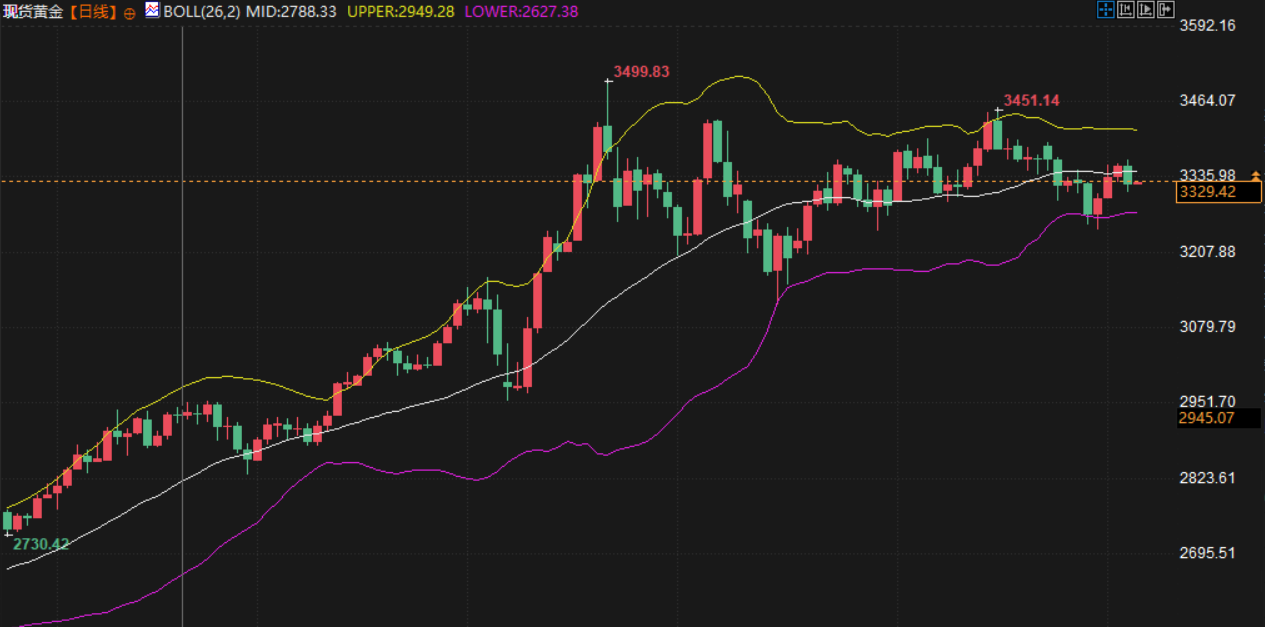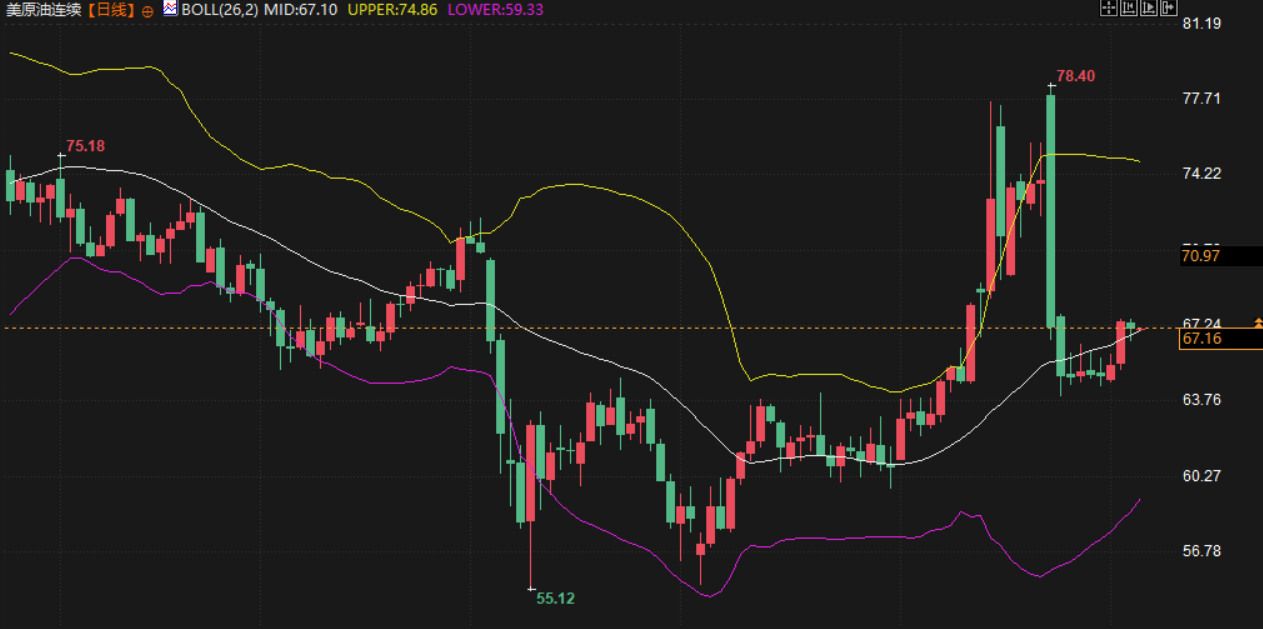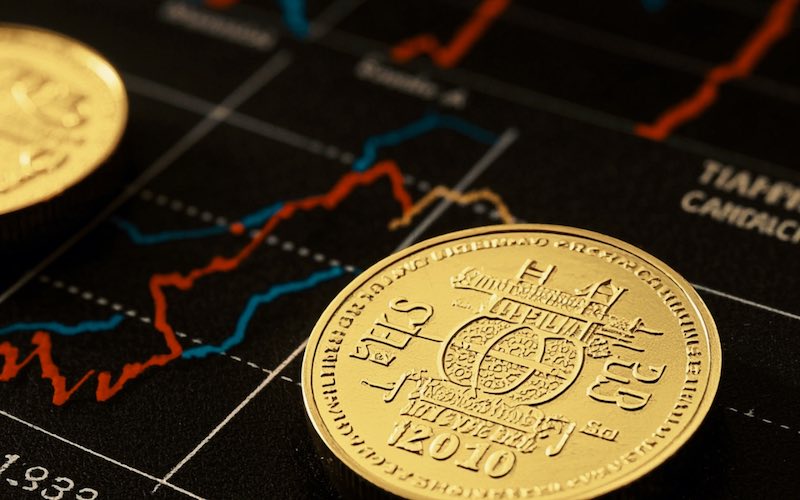July 4 Financial Breakfast: Strong non-farm payrolls dampened expectations of a Fed rate cut, gold price gains were limited, and the U.S. Treasury Secretary warned that tariffs may return to April 2 levels
2025-07-04 07:19:36

Focus on the day

stock market
U.S. stocks rose to a record high on Thursday, with chipmaker Nvidia's market value approaching $4 trillion, while an unexpectedly strong U.S. jobs report cheered investors who shrugged off slim hopes for a U.S. interest rate cut this month.
The S&P 500 and Nasdaq both closed at record highs, posting their third straight weekly gain. The Dow Jones Industrial Average closed up 0.41%, near its all-time high.
Chipmaker Nvidia rose 1.3%, with a market value of $3.89 trillion. The company is about to surpass Apple to become the world's most valuable company in history. Friday was the Independence Day holiday in the United States, and trading hours on Thursday were shortened and trading volume was small.
“We’re experiencing a real bout of irrational exuberance; the stock market is very biased toward optimism,” said Kristina Hooper, chief market strategist at Man Group in New York. “But it’s based on something. I think there’s a degree of relief that the jobs report wasn’t as weak as people thought.”
She said the rally was driven by retail investors who have largely ignored looming inflationary pressures and uncertainty about tariffs and are "focusing on the real stuff, which is today's jobs report."
The S&P 500 rose 0.83% to 6,279.36 points; the Nasdaq rose 1.02% to 20,601.10 points; and the Dow Jones Industrial Average rose 0.77% to 44,828.53 points.
Data showed that nonfarm payrolls increased by 147,000 in June, 33% more than the 110,000 forecast by economists polled by Reuters. The unemployment rate fell to 4.1% in June, better than the expected 4.3%.
Traders were quick to rule out a July rate cut, with markets pricing in a 68% chance of a 25 basis point cut in September, down from 74% a week ago, according to CME Group’s Fedwatch tool.
The U.S. House of Representatives passed President Trump's massive tax cut and spending bill with a push from Republican lawmakers, overcoming divisions within the party over its cost.
Nonpartisan analysts say the bill is expected to add $3.4 trillion to the nation's current $36.2 trillion debt over the next decade.
Big tax cuts and increased government spending can stimulate demand in the economy. This can add to inflationary pressures, especially if the economy shows signs of strength, such as the latest jobs report.
“Some of the data like the jobs report was positive and attractive, but if we step back, it’s not as positive,” said Alex Morris, CEO of F/m Investments.
For the week, the S&P 500 rose 1.72%, the Nasdaq rose 1.62% and the Dow rose 2.3%. The Russell 2000 small-cap index rose 3.41%. "It's a little confusing," Morris said. "It feels like the last wave of the bull run before all the data really comes together."
U.S. stocks closed early at 1:00 pm Eastern Time. Total trading volume on U.S. exchanges was 10.85 billion shares, well below the 17.82 billion daily average over the past 20 full trading days.
Gold Market
Gold fell 1% on Thursday as stronger-than-expected U.S. jobs data reinforced expectations that the Federal Reserve is unlikely to cut interest rates as soon as previously expected, denting bullion's appeal.

Spot gold fell 0.9% to $3,328.63 an ounce, having fallen more than 1% in early trading. U.S. gold futures closed up 0.4% at $3,342.9.
The dollar and U.S. stock futures rose after the Bureau of Labor Statistics reported nonfarm payrolls increased by 147,000 jobs last month. Economists polled by Reuters had forecast payrolls would increase by 110,000. A stronger dollar makes gold more expensive for overseas buyers.
"The better-than-expected payrolls mean we think the Fed is less likely to cut rates earlier than currently expected," said David Meger, director of metals trading at High Ridge Futures. As a result, the dollar is stronger, which adds pressure on the gold market. "The key point is that the idea or possibility of a rate cut in July is no longer in the cards."
Investors currently expect the Fed to cut interest rates by 51 basis points by the end of the year, starting in October, down from expectations of about 66 basis points before the report was released.
Spot silver was at $36.84 an ounce, up 0.7%; platinum was at $1,374.89, down 3.1%; and palladium was at $1,137.69, down 1.5%.
Oil Market
Oil prices fell slightly on Thursday as investors worried that U.S. tariffs could slow energy demand and as major crude producers were expected to increase supply.

Brent crude futures fell 0.45% to settle at $68.80 a barrel, while U.S. crude futures fell 0.67% to settle at $67.00 a barrel. Trading volumes were light ahead of the Independence Day holiday.
A 90-day pause in President Trump's tariff hikes ends on July 9, and several large trading partners, including the European Union and Japan, have yet to reach trade deals. Oil traders worry about the impact on the economy and fuel demand.
A tentative trade deal between the United States and Vietnam boosted oil prices on Wednesday, but uncertainty about overall tariffs remained high.
Oil prices were also pressured by an expected agreement by OPEC+ to raise output by 411,000 bpd at a policy meeting this weekend. An unexpected build in U.S. crude inventories also heightened demand concerns in the country.
The U.S. Energy Information Administration (EIA) said on Wednesday that domestic crude oil inventories in the United States rose by 3.8 million barrels to 419 million barrels last week. Analysts polled by Reuters had expected inventories to fall by 1.8 million barrels.
U.S. energy companies cut the number of active oil rigs, a measure of future output, by seven this week to 425, the lowest since September 2021, according to a report from energy services firm Baker Hughes on Thursday.
Data on Thursday showed solid U.S. job growth in June and an unexpected drop in the unemployment rate. However, nearly half of the new nonfarm payrolls came from the government sector, and private sector job growth slowed sharply as industries such as manufacturing and retail struggled to cope with Trump's sharp increase in tariffs on imports.
David Laut, chief investment officer at Abound Financial, said: "Thursday's employment report was stronger than expected, which shows that the economic resilience we have seen in the past few months remains intact. We still expect the Federal Reserve to continue to take a wait-and-see approach to interest rates."
Foreign exchange market
The dollar rose against major currencies including the yen, euro and Swiss franc on Thursday after data showed the U.S. economy created more jobs than expected, suggesting it might take longer for the Federal Reserve to cut interest rates.

The dollar rose 0.94% against the yen to 145.075 yen and 0.39% against the Swiss franc to 0.7955 Swiss franc. The dollar was on track for a second straight day of gains against both safe-haven currencies. The euro fell 0.41% to $1.175350, falling for a second straight day.
Data released by the U.S. Labor Department on Thursday showed that nonfarm payrolls increased by 147,000 in June. Economists polled by Reuters had forecast an increase of 110,000. The report was released a day early due to the July 4 Independence Day holiday.
“It’s going to be very difficult for the Fed to cut rates in an environment where the labor market is so strong,” said Axel Merk, president and chief investment officer of Merk Hard Currency Fund in California. “Powell’s argument for the Fed to stay on the sidelines still holds.”
The dollar index, which measures the greenback against a basket of currencies including the yen and the euro, rose 0.40% to 97.135, marking two straight sessions of gains but still trading near multi-year lows.
The dollar rose after the data, while U.S. Treasury yields also rose. The two-year Treasury yield, which often moves in sync with Federal Reserve interest rate expectations, rose 9.7 basis points to 3.789%. The benchmark 10-year Treasury yield rose 5.5 basis points to 4.348%.
U.S. stocks rose, with the benchmark S&P 500 and Nasdaq hitting new intraday highs. "As things stand, the U.S. economy is expected to outperform for the rest of the year, which is why we have seen such a strong reaction in the stock market over the past three weeks," said Joseph Trevisani, senior analyst at FX Street. The dollar has fallen about 13% against the euro since February. This is largely due to market speculation that the Federal Reserve will cut interest rates sooner or later." He said Thursday's economic data has dispelled those expectations.
Market expectations for the probability that the Federal Reserve will keep interest rates unchanged at its July meeting rose to 95.3% from 76.2% a day earlier, according to CME Group's Fedwatch tool.
The U.S. House of Representatives on Thursday passed President Donald Trump's massive tax cut and spending bill, sending it to Trump to sign into law.
U.S. Treasury Secretary Jeff Besant said in an interview with Bloomberg that he expects a series of trade deals to be reached before the tariff suspension expires on July 9.
Sterling rose after falling in the previous session as British government bonds sold off. British Prime Minister Starmer's office backed Chancellor of the Exchequer Reeves, easing concerns about her future. Sterling rose 0.07% to $1.3646.
International News
Trump and Putin had their sixth phone call, and the Kremlin hinted that there was little progress on the ceasefire between Russia and Ukraine
Russian President Vladimir Putin and U.S. President Donald Trump discussed Ukraine in a phone call on Thursday. The Kremlin suggested Trump's efforts to promote a ceasefire had made little progress. "Donald Trump once again raised the issue of an early cessation of hostilities," Kremlin foreign policy aide Yuri Ushakov told reporters. Ushakov added that Putin said Russia "will not give up" its war goals. The two leaders' call on Thursday lasted nearly an hour. Ushakov called the talks "candid, pragmatic and concrete," adding that the two leaders agreed to resume communication soon. He said Putin and Trump also discussed Iran and the situation in the Middle East "in considerable detail." He said the two leaders did not discuss a meeting or the U.S. decision to stop supplying arms to Ukraine.
U.S. trade deficit widens in May
The U.S. trade deficit widened in May as U.S. exports fell. According to the Commerce Department, imports fell slightly to $350.5 billion in May, down from $350.8 billion in April. But exports fell more sharply, to $279.0 billion from $290.6 billion in April. This led to a trade deficit of $71.5 billion, up 19% from $60.3 billion in April and higher than the $70.9 billion that economists had expected. The White House's negotiating stance has made monthly trade data volatile this year.
The probability of a rate cut in July is close to zero. Strong employment data makes U.S. bond traders give up their bets
U.S. Treasury prices plunged as a stronger-than-expected nonfarm payrolls report prompted traders to withdraw bets on a Fed rate cut this month. Short-term Treasurys led the decline, with 2-year and 5-year yields rising nearly 10 basis points, and the 10-year yield jumping 6 basis points to 4.34%. Gregory Faranello, head of U.S. interest rate trading and strategy at AmeriVet Securities, said there was little chance of a rate cut in July, "the Fed will pause in the summer," and "employment data is key to the Fed's policy adjustments," and the report provided room for Powell to continue to stay on the sidelines. Interest rate swap data showed that traders believed the probability of a rate cut at the July 29-30 meeting had fallen to near zero, while the probability of a rate cut in September was about 75%. The data showed that nonfarm payrolls increased by 147,000, significantly higher than the median estimate of 106,000 in a Bloomberg survey, and the data for the first two months were slightly revised up. The unemployment rate fell from 4.2% to 4.1%.
U.S. jobless claims fall to six-week low
Data released by the U.S. Department of Labor on Thursday showed that the seasonally adjusted number of initial unemployment claims fell by 4,000 to 233,000 in the week ending June 28, hitting a six-week low since mid-May and lower than the 240,000 forecast by economists. However, the total number of continuing unemployment claims in the week ending June 21 remained at a high of 1.964 million, the highest level since the fall of 2021.
U.S. Treasury secretary warns tariffs could return to April 2 levels
U.S. Treasury Secretary Benson warned America's trading partners not to extend trade talks, saying that if no progress is made, tariffs could rise back to April 2 levels. Benson revealed that he would meet with EU negotiators today. When asked about the outcome of the discussion, he simply said, "We'll see what happens with the EU." On the issue of U.S. debt, Benson expressed confidence in market demand. He said that "there is a lot of demand for U.S. Treasuries," and demand for U.S. Treasuries at home and abroad remains strong. He described the debt management process as "orderly." Benson also commented on interest rates, suggesting that "two-year Treasury bonds tell you that overnight rates are too high" and that "inflation expectations should fall back." He criticized the Federal Reserve, saying that the committee's judgment "seems a little bit off." Regarding the operation of the Federal Reserve, Benson said that "it is good for the Federal Reserve to control spending" and that he hopes to "see the Federal Reserve reasonably adjust the size of the budget." When asked if he hopes that Federal Reserve Chairman Powell will resign, Benson declined to give a specific response. He pointed out that there are "a lot of strong candidates for Federal Reserve Chairman" and mentioned the possibility of "filling two Federal Reserve board positions next year."
Japan's Senate election kicks off: Experts: Ishiba Cabinet may face severe challenges
The 27th Japanese Senate election was announced on the 3rd, and the registration of candidates started on the same day. The voting day is set for the 20th of this month. In last year's House of Representatives election, the ruling coalition of the Liberal Democratic Party and the Komeito Party failed to win a majority of seats. Japanese experts and scholars said that the Ishiba Cabinet is currently facing many issues, and this Senate election may face severe challenges. (CCTV)
Zelensky signs bill allowing transfer of mineral extraction funds to Ukrainian-US reconstruction fund
According to CCTV News, according to the official website of the Ukrainian Verkhovna Rada (Parliament) on July 3, local time, Ukrainian President Zelensky signed a bill to amend the Budget Code, allowing the transfer of mineral mining funds to the Ukraine-US Reconstruction Investment Fund. On May 1, local time in Ukraine, Ukrainian First Deputy Prime Minister and Minister of Economy Svirizenko revealed on social media that according to the agreement reached between Ukrainian President Vladimir Zelensky and US President Donald Trump, she and US Treasury Secretary Scott Bessant jointly signed the "Agreement on the Establishment of the US-Ukraine Reconstruction Investment Fund", which was previously referred to as the "US-Ukraine Mineral Agreement" by all parties. The agreement intends to create a fund with a 50% participation ratio for both parties.
US continues 'maximum pressure' on Iran with new sanctions to restrict oil trade
The United States has again taken steps to restrict Iran's oil trade, increasing pressure on the country even though Trump had previously hinted that sanctions might be eased after bombing Iran's nuclear facilities. The U.S. Treasury Department and the State Department announced sanctions on companies and a "shadow fleet" that helped Iran export crude oil on Thursday. The U.S. Treasury's sanctions target a network of companies accused of buying and transporting billions of dollars worth of Iranian oil. The U.S. Treasury Department said some of the proceeds from oil sales went to the Quds Force of Iran's Islamic Revolutionary Guard Corps, which the United States has designated as a terrorist organization. Treasury Secretary Scott Bessant said in a statement that the Treasury Department will continue to target Tehran's sources of revenue and increase economic pressure to prevent the regime from obtaining sources of funds for its destabilizing activities. At the same time, the U.S. State Department imposed penalties on six companies, including four ships that helped Iran export oil. The two departments specifically pointed out that these ships helped Iran circumvent sanctions by loading cargo from Iranian ships and concealing their origin. (Refinitiv)
Domestic News
The second phase of the largest photovoltaic storage and charging project in my country's offshore oil and gas equipment manufacturing field is put into operation
According to the Offshore Oil Engineering Co., Ltd., the second phase of the largest integrated distributed photovoltaic, power storage and charging pile project in my country's offshore oil and gas equipment manufacturing field has been fully put into use at the Offshore Oil Engineering Zhuhai Deepwater Equipment Manufacturing Base. The project is divided into three phases, of which the first phase was put into use in July 2023, with an installed capacity of 6,500 kilowatts and an annual power generation of 6.45 million kWh. The distributed photovoltaic project put into production this time covers a total area of 80,000 square meters, with an installed capacity of 9,300 kilowatts. It can add 9.2 million kWh of power generation each year on the basis of the clean energy power generation of the first phase project, further reducing dependence on non-renewable energy sources such as thermal power generation.
- Risk Warning and Disclaimer
- The market involves risk, and trading may not be suitable for all investors. This article is for reference only and does not constitute personal investment advice, nor does it take into account certain users’ specific investment objectives, financial situation, or other needs. Any investment decisions made based on this information are at your own risk.










